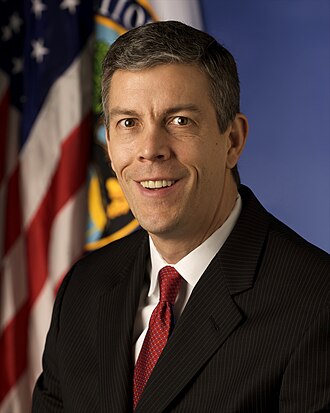Discover Your Roots
SIGN UPDiscover Your Roots
SIGN UPArne is a male name of German origin, meaning "Eagle." The name is rooted in strength and freedom, reflecting the symbolism of the majestic bird. In addition to its linguistic significance, Arne is associated with various places, including a village in Dorset, England, and nature reserves in both England and France. It has also been used as a given name and surname for several individuals, as well as fictional and mythological characters. Notably, Arne is linked to Greek mythology and is also the name of one half of the Norwegian design duo, Arne & Carlos. The name's historical and cultural connections add depth to its significance. Whether through its symbolic meaning or its diverse associations, Arne carries a sense of power and distinction.

Arne Starkey Duncan, born on November 6, 1964, is a prominent American educator and former professional basketball player. He served as the 9th United States Secretary of Education from 2009 to 2015 and as the Chief Executive Officer of Chicago Public Schools from 2001 to 2008. Duncan is known for his significant contributions to education policy, particularly in the development of Common Core, a set of nationwide educational standards, during his tenure as Secretary of Education. Additionally, he is the founder of Create Real Economic Destiny (CRED), a non-profit organization dedicated to reducing gun violence. Raised in Chicago, Duncan is deeply rooted in the local community, with his mother running the Sue Duncan Children's Center, an after-school program serving African-American youth. Duncan's career has been multifaceted, as he excelled both in sports and academia. He played professional basketball, including stints in Australia's National Basketball League and participation in NBA All-Star Weekend Celebrity Games. After his basketball career, Duncan delved into education, working with programs mentoring children and later becoming a pivotal figure in the charter school movement in Chicago. As the CEO of Chicago Public Schools, he spearheaded the implementation of the Renaissance 2010 initiative and earned both praise and criticism for his efforts. During his tenure as U.S. Secretary of Education, Duncan launched the Race to the Top competition aimed at reforming education and improving student outcomes. Despite being a controversial figure, Duncan's

Arne Emil Jacobsen (1902–1971) was a prominent Danish architect and furniture designer known for his influential contribution to architectural functionalism and his globally acclaimed simple and well-designed chairs. Born in Copenhagen, Jacobsen initially aspired to be a painter but was steered toward architecture, ultimately studying at the Royal Danish Academy of Fine Arts. His early designs were influenced by the works of leading architects such as Le Corbusier, Mies van der Rohe, and Walter Gropius.In the pre-World War II era, Jacobsen gained recognition with projects like the Rothenborg House and the Bellevue Sea Bath, which showcased his meticulous attention to detail and commitment to functionalist principles. Despite facing public opposition to his avant-garde style, Jacobsen continued to make significant architectural contributions, including the controversial Stelling House on Gammeltorv and the Århus City Hall, which is now regarded as one of his most important works.During World War II, Jacobsen experienced scarcity of building materials, leading to a temporary shift in focus to smaller-scale designs and furniture. Upon his return, he continued to leave an indelible mark on the architectural landscape with innovative projects that reflected his modernistic vision.Arne Jacobsen's enduring legacy lies in his pioneering spirit, which transcended traditional architectural norms and continues to inspire contemporary design and functional aesthetics.

Arne Helge Carlson, born on September 24, 1934, served as the 37th governor of Minnesota from 1991 to 1999. He is known as a liberal Republican and had a successful career in politics. Born into poverty in New York City to Swedish immigrant parents, Carlson pursued education with determination, attending the Choate Rosemary Hall preparatory school on a scholarship and later earning a Bachelor of Arts degree in history from Williams College. He then pursued graduate studies at the University of Minnesota. Carlson's political career began with his election to the Minneapolis City Council in 1965, later serving in the Minnesota House of Representatives and as the Minnesota State Auditor from 1979 to 1991.In 1990, Carlson secured the Republican nomination for governor of Minnesota after a turbulent primary election. Despite initial challenges, he emerged as the winner in the general election, defeating incumbent governor Rudy Perpich. During his tenure as governor, Carlson made significant contributions to the state, serving from January 7, 1991, to January 4, 1999. He has remained active in supporting Democratic (DFL) candidates while maintaining his Republican affiliation. Carlson's dedication to public service and his impact on Minnesota's political landscape have solidified his legacy as a prominent figure in American politics.

Arne Anka is a Swedish comic strip created by Charlie Christensen, known for its sharp wit and cynical commentary on Swedish society. The title character, Arne, is a heavy drinker who often muses on life while frequenting a bar called Zeke's with his friend, Krille Crocodile. Despite drawing inspiration from Donald Duck, Arne Anka's comics are far from the light-hearted nature of Disney's creation. The character's love for Swedish literature, financial struggles, and lack of success with women make him a relatable yet complex figure. In 1990, the comic faced a legal threat from the Nordic division of the Walt Disney Company due to its resemblance to Donald Duck. However, Christensen cleverly navigated this issue, resulting in a surge in Arne Anka's popularity and making the character a symbol of Swedish pride and defiance. The comic has been adapted into a play and several albums, further solidifying its cultural impact. With its unique blend of humor and social commentary, Arne Anka continues to captivate audiences and remains a significant figure in Swedish pop culture.

Arne Larsson (26 May 1915 – 28 December 2001) is renowned as the first person to receive an artificial cardiac pacemaker. This groundbreaking medical milestone was achieved when Åke Senning implanted the first two pacemakers in 1958. Despite facing health challenges, Arne lived for another forty-three years and underwent twenty-six pacemaker replacements. Tragically, he passed away from melanoma on 28 December 2001, after being diagnosed two years prior. Arne Larsson's legacy continues to inspire medical advancements in the field of cardiology and serves as a testament to the resilience of the human spirit.
All images displayed on this page are sourced from Wikipedia or Wikimedia Commons.We use these images under their respective Creative Commons or public domain licenses. Wherever applicable, author attributions and license information are provided. If you believe an image is used incorrectly or outside its license terms, please contact us so that we can review and correct the issue.